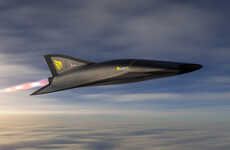
References: aerioncorp
The Concorde may be gone, but Aerion Corp is developing the next generation of supersonic jet. The plan is to create a plane that could rocket you from the East Coast to Asia in under ten hours.
The project itself has been in development for a couple of years. Here's the latest business update, "Since its public unveiling in 2004, the design of the Aerion supersonic business jet has been refined and validated through high-order computer analysis and wind tunnel testing. Meanwhile, the company continues to build its business case, providing a more detailed financial picture of the costs, risks and rewards involved in program participation."
And here is the latest technical update: "Configuration optimization: While performance and size parameters of the aircraft have changed little in the last year, optimization continues on such complex areas as engine inlets and exhaust nozzles, as well as the nacelle/airframe integration. In particular, the aft fuselage and nacelle external lines are being computationally optimized for drag in the presence of the hot exhaust flow. Tail size and geometry are also the subject of optimization in conjunction with computational stability and control evaluations based on previous wind tunnel tests. The net result of this work is to improve the Aerion jet's supersonic and transonic range performance."
The project itself has been in development for a couple of years. Here's the latest business update, "Since its public unveiling in 2004, the design of the Aerion supersonic business jet has been refined and validated through high-order computer analysis and wind tunnel testing. Meanwhile, the company continues to build its business case, providing a more detailed financial picture of the costs, risks and rewards involved in program participation."
And here is the latest technical update: "Configuration optimization: While performance and size parameters of the aircraft have changed little in the last year, optimization continues on such complex areas as engine inlets and exhaust nozzles, as well as the nacelle/airframe integration. In particular, the aft fuselage and nacelle external lines are being computationally optimized for drag in the presence of the hot exhaust flow. Tail size and geometry are also the subject of optimization in conjunction with computational stability and control evaluations based on previous wind tunnel tests. The net result of this work is to improve the Aerion jet's supersonic and transonic range performance."
Trend Themes
1. Supersonic Air Travel - The development of supersonic jets presents an opportunity for airlines and aerospace companies to tap into a new market and offer faster travel times.
2. Computational Optimization - Advancements in computational optimization can lead to more efficient and optimized aerospace design, potentially reducing costs and improving performance.
3. Wind Tunnel Testing - Investing in wind tunnel testing can help in validating aircraft designs and improving overall performance, leading to disruptive innovations in aerospace engineering and design.
Industry Implications
1. Aerospace - The aerospace industry can benefit from the development of supersonic jets and advancements in computational optimization and wind tunnel testing to create faster and more energy-efficient aircraft.
2. Travel - If the development of supersonic jets is successful, the travel industry could see a significant reduction in travel times, opening up new destinations and possibilities for travelers.
3. Engineering - The development of supersonic jets and advancements in aerospace design and technology provide an opportunity for engineers to create disruptive innovations in the aerospace industry.
1.7
Score
Popularity
Activity
Freshness























